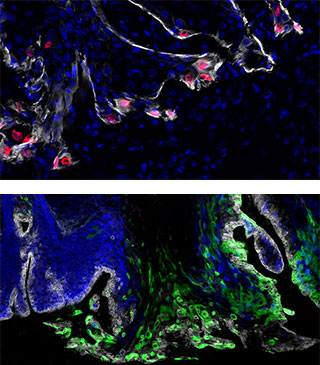Growth Signal Can Influence Cancer Cells’ Vulnerability to Drugs, Study Suggests

Zach Veilleux A cue for cancer: To see how exposure to the growth signal TGF-β influences cancer cells, the researchers used a red tag (top) to mark mouse tumor stem cells that received the signal, and a green tag (bottom) to track the behavior the stem cells’ progeny.
“There are several reasons why some cancer stem cells, the cells at the root of tumors and metastases, can withstand therapy meant to eradicate them. Our results point to the importance of the environment immediately surrounding the skin cancer stem cells, specifically, their exposure to the signal TGF-β,” says senior researcher Elaine Fuchs, Rebecca C. Lancefield Professor, head of the Robin Chemers Neustein Laboratory of Mammalian Cell Biology and Development and a Howard Hughes Medical Institute Investigator.
“Ultimately, we hope this new insight could lead to better means for preventing the recurrence of these life-threatening cancers, which can occur in the skin, head, neck, esophagus, and lung, and often evade treatment.”
Her team, which included first author Naoki Oshimori, a postdoctoral research associate in the lab and lab technician Daniel Oristian, focused on squamous cell carcinomas in the skin of mice. Like many normal tissue stem cells, the stem cells that produce squamous cell tumors can be classified into two types: those that divide and proliferate rapidly, and those that do so more slowly. This has led scientists to wonder whether the more dormant stem cells in a tumor might evade cancer drugs.
To investigate this possibility, the team zeroed in on TGF-β (transforming growth factor beta) which is known to restrict growth in many healthy tissues. The lab’s previous research has shown that mice whose normal skin stem cells cannot respond to TGF-β become susceptible to develop tumors that grow rapidly. Paradoxically, however, TGF-β contributes to metastasis in many cancers. The researchers wanted to know: How can TGF-β act both to suppress cancers and promote them?
By visualizing TGF-β signaling within developing mouse tumors, the researchers found that the cancer stem cells located nearest to the blood vessels of the tumor receive a strong TGF-β signal, while others further away don’t receive any. To see this difference and its effects, they used a red tag to illuminate those cells exposed and responding to TGF-β, and a green genetic tag, which they could switch on, to track the stem cells’ progeny. Over time, they saw that TGF-β-responding stem cells proliferate more slowly but they simultaneously invade, scatter and move away from the tumor. The opposite was true of cancer stem cells too far away to receive TGF-β, which proliferated rapidly, but were less invasive, growing as a tumor mass.
“We tested the implications for drug resistance by injecting cisplatin, a commonly used chemotherapy drug for these types of cancers, into the mice with tumors. While the drug killed off most of the TGF-β nonresponding cancer cells, it left behind many of the responders,” Oshimori says. “When the drug was withdrawn, the lingering TGF-β responding cancer stem cells grew back the tumor.”
“We found that the TGF-β heterogeneity in the tumor microenvironment produces some cancers stem cells that divide rapidly and lead to accelerated tumor growth, and other cancer stem cells that invade surrounding healthy tissue and escape cancer therapies,” Fuchs explains. “Moreover, conventional wisdom might say that a leisurely pace of cell division, like that seen in the TGF-β responders, makes it possible for these cells to circumvent anticancer treatments that target rapidly dividing cells. While this may be true for some types of anticancer drugs, we found changes in antioxidant activity in these cells are more important for their resistance to cisplatin.”
Indeed, when the team compared the genes expressed by the TGF-β responders with those of the nonresponders, they found highly elevated expression in a battery of genes encoding enzymes involved in making and utilizing glutathione, an important antioxidant and detoxifying substance in cells. This unexpected finding led the team to test the impact of glutathione metabolism and conclude this metabolic pathway prevents TGF-β responders from critical damage by anti-cancer drugs as well as oxidative stresses.
“If TGF-β signaling and elevated antioxidant activity plays the same role predisposing cancer stem cells to thwart chemotherapy in humans as we have shown it does in mice, this work may serve as a foundation for designing new therapeutics and combinatorial regiments to overcome drug resistance by this devastating cancer,” Fuchs says.
Contact Information
Zach Veilleux
212-327-8982
newswire@rockefeller.edu
Media Contact
All latest news from the category: Life Sciences and Chemistry
Articles and reports from the Life Sciences and chemistry area deal with applied and basic research into modern biology, chemistry and human medicine.
Valuable information can be found on a range of life sciences fields including bacteriology, biochemistry, bionics, bioinformatics, biophysics, biotechnology, genetics, geobotany, human biology, marine biology, microbiology, molecular biology, cellular biology, zoology, bioinorganic chemistry, microchemistry and environmental chemistry.
Newest articles

Silicon Carbide Innovation Alliance to drive industrial-scale semiconductor work
Known for its ability to withstand extreme environments and high voltages, silicon carbide (SiC) is a semiconducting material made up of silicon and carbon atoms arranged into crystals that is…

New SPECT/CT technique shows impressive biomarker identification
…offers increased access for prostate cancer patients. A novel SPECT/CT acquisition method can accurately detect radiopharmaceutical biodistribution in a convenient manner for prostate cancer patients, opening the door for more…

How 3D printers can give robots a soft touch
Soft skin coverings and touch sensors have emerged as a promising feature for robots that are both safer and more intuitive for human interaction, but they are expensive and difficult…





















